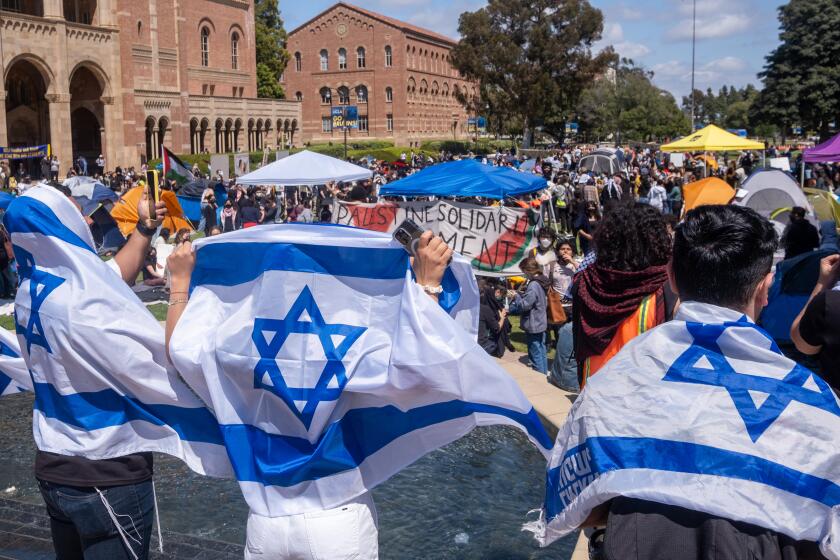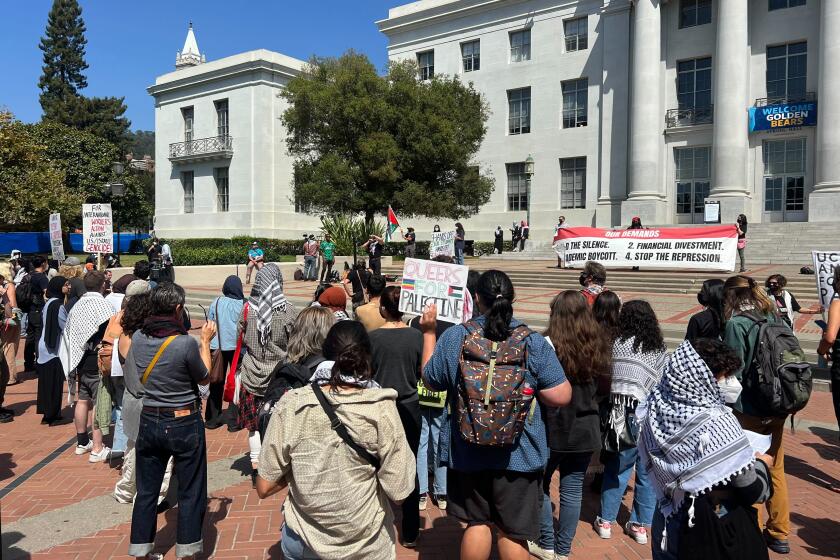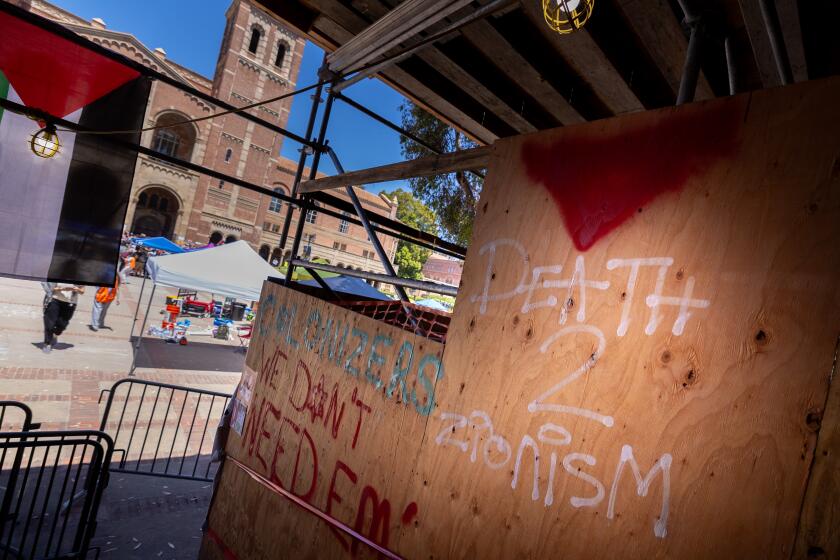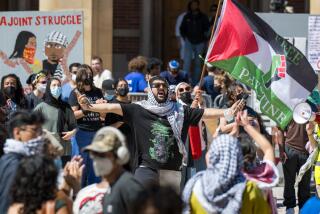Two major reports slam UCLA over policing, violence at pro-Palestinian protest

- Share via
- A report to the L.A. Police Commission faults poor coordination between UCLA police, LAPD and other agencies during spring protests.
- UCLA’s response to spring protests contributed to campus antisemitism, a highly critical Congressional committee report said.
Two high-profile, back-to-back reports slam UCLA for a confusing breakdown in its police response leading to violence at a pro-Palestinian encampment in April, with one investigation also calling out the university’s “dramatic failures in confronting antisemitism.”
A draft report to the Los Angeles Police Commission released Friday cited a lack of coordination between UCLA, the LAPD and the California Highway Patrol and smaller municipal police agencies that were hastily called to campus in the spring.
UCLA, which has its own police force, had distanced itself from relying on the LAPD in the wake of Black Lives Matter protests four years ago, a practice that contributed to the poorly coordinated response, the report suggested. Some arriving teams of officers did not even know their way around the sprawling campus and were subjected to conflicting orders about what to do as a melee unfolded for hours in front of them the night of April 30.

The LAPD should take the lead on campus law enforcement ahead of future “large scale events” if university staffing isn’t adequate, said the report, which was compiled by the LAPD and submitted by Interim Police Chief Dominic H. Choi to the commission. The civilian agency, which is tasked with LAPD oversight, could approve it as early as its next meeting Tuesday.
The report to the commission came on the heels of a congressional probe that pilloried the university for allowing antisemitism to foment on campus during pro-Palestinian protests.
UCLA students and faculty raise alarm on antisemitic and anti-Palestinian hate amid ongoing protests
Nearly six months after vigilantes attacked a pro-Palestinian encampment at UCLA, antiwar protests — and concerns over anti-Jewish and anti-Muslim sentiment on campus — continue. Two separate faculty task forces trying to address the issues have come to different conclusions.
The Republican-led U.S. House Committee on Education and the Workforce criticized UCLA and other elite universities, including Harvard and Columbia, for “dramatic failures in confronting antisemitism.” The report — which drew upon emails between UCLA police, UCLA administrators, UC President Michael V. Drake and UC regents — followed explosive committee hearings in the last year that contributed to the resignations of presidents of Harvard, Columbia, Rutgers and the University of Pennsylvania.
In a statement, UCLA Associate Vice Chancellor for Campus Safety Rick Braziel said the findings and recommendations sent to the police commission were under review.
“Meanwhile, both UCLA and the University of California Office of the President are conducting separate reviews of the events that took place last spring, and UCLA has already been implementing a host of measures to improve campus safety,” Braziel said.
In a separate university statement on the congressional report, UCLA said it was “committed to combating antisemitism and fostering an environment where every member of our community feels safe and welcome. We have learned valuable lessons from the events of last spring, and ahead of the start of this academic year, instituted reforms and programs to combat discrimination and enhance campus safety.”
In August, Drake directed chancellors of all 10 campuses to strictly enforce rules against encampments, protests that block pathways and masking that shields identities amid sharp calls to stop policy violations during demonstrations.
Early signs of trouble
The combined narrative of both reports offers the most detailed timeline on events leading up to the night of violence that began April 30, with repercussions spanning through May 2, when a massive police sweep of the encampment led more than 200 arrests and six uses of police force.
In a UCLA police message thread on April 25, five days before the violence, a patrol officer suggested police should identify and remove people who were not UCLA students, staff and faculty from the recently formed encampment at Royce Quad in the center of campus, the House report said. An unidentified individual responded that UCLA had decided to “hold off.”
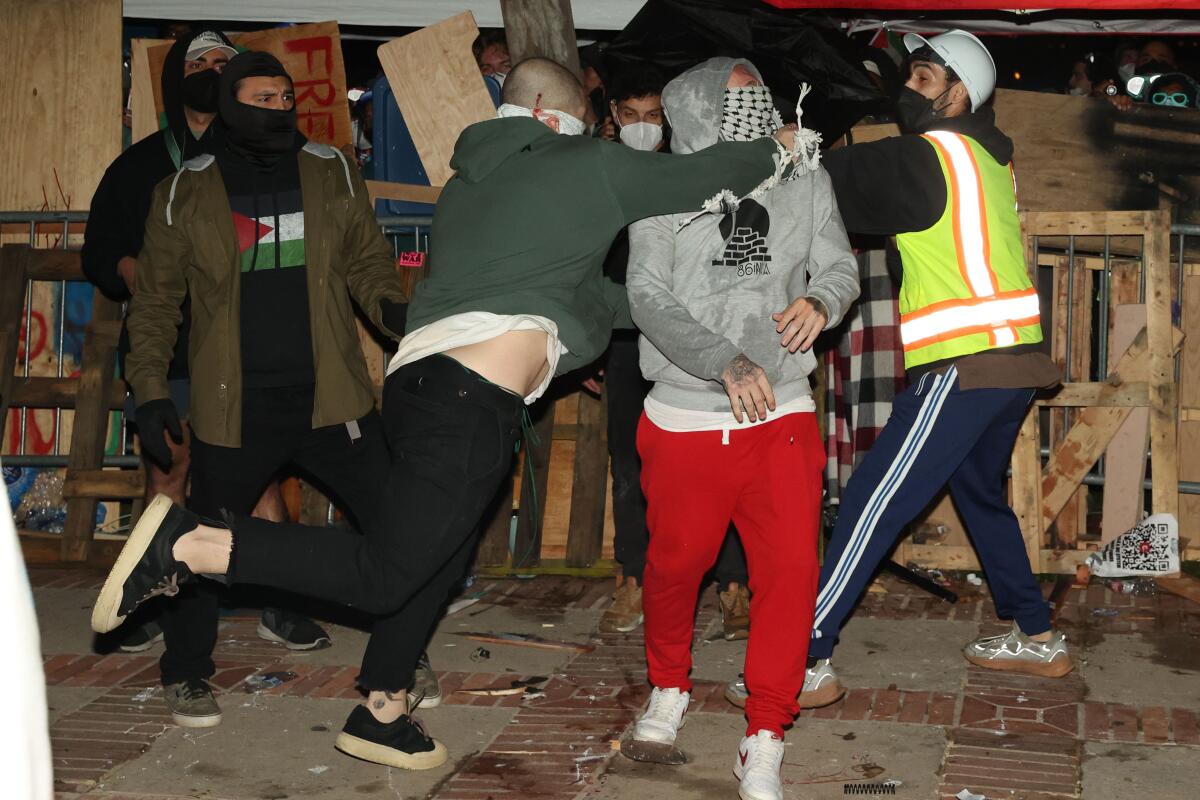
Around 5 a.m. on April 25, then-UCLA Police Chief John Thomas texted LAPD commanders Steve Lurie and Jonathan Tom to inform them that multiple tents were being set up on campus and that UCLA “may need some assistance as the day progresses,” said the police commission report.
On April 25, a UCLA police lieutenant informed Thomas that more than 50 unidentified people were unloading wood, tents and other materials from a truck at Royce Quad. UCLA closed off a nearby street to prevent further access, but the erection of tents in the area of Royce Quad and Powell Library continued, the House committee report said.
The encampment grew to more than 150 people with tents surrounded by wooden pallets, with the university fire marshal warning that the use of wood was not advised, the House committee report said.
“Over the course of the next day, it became apparent to UCPD and campus administrators that the university was underequipped,” according to the House report, which largely summarized university emails.
“UCLA leaders worried that they would be unable to restrict access to the area or prevent further expansion of the encampment without a significant surge in manpower, with one senior administrator warning that ‘no temporary fence is going to keep these people out,’” the House report said.
On April 27, Choi approved the deployment of two LAPD mobile response squads to campus to stand by. Thomas told Choi that Beverly Hills, Culver City and Santa Monica were also sending squads and that the LAPD would be the last resort.
The following morning, Thomas wrote in a group chat with other law enforcement leaders that more pro-Palestinian protesters planned to go to campus. A few minutes later, an LAPD lieutenant texted his colleagues to say that UCLA had “no plans” to clear out protesters, the report said.
Even before Tuesday night’s bloody physical altercations, protesters occupying a pro-Palestinian encampment at UCLA said counterdemonstrators have assaulted them nightly with a jarring barrage of light and sound.
By 10:30 a.m., more than 1,000 pro-Israel counterprotesters arrived by the encampment.
That morning, a single squad car from West L.A. was dispatched to monitor the protest. By 10:41 a.m., police began receiving reports that protesters and counterprotesters were “getting physical.”
Additional LAPD officers were sent to campus. About 11:14 a.m., the LAPD lieutenant texted Lurie to say that UCLA had requested the LAPD’s help in clearing out the protesters. But he responded that the LAPD would not participate in making arrests.
Around 1:34 p.m., Lurie texted a group of LAPD senior staff to inform them that the pro-Israel protest crowd was thinning out and UCLA administrators were discussing how and when to clear the encampment. Choi responded that the LAPD would not be involved in clearing out the area. About 90% of the pro-Israel group left within the hour.
There were further moments of tension during the next two days, as coordination with the LAPD showed signs of being disjointed, the report to the police commission indicated.
It exploded the night of April 30 as vigilantes arrived to attack the encampment.
As reports of clashes began to increasingly pick up, UCLA police leaders contacted Lurie to let him know that campus police were being overwhelmed by the crowd.
While the initial message was sent at 11:07 p.m., campus police officials didn’t make an official request for mutual aid until 11:31 p.m. and again 10 minutes later, the commission report said. The first LAPD units arrived on campus by 12:12 a.m. By about 1:45 a.m., several mobile response squads waded into the melee to try to separate protesters and counterprotesters who’d converged near a flagpole.

But they took “no further action to clear the crowds” because they were still formulating a plan and awaiting backup, the commission report said. Under the department’s crowd control rules, officers are supposed to wait for “sufficient personnel” before entering a crowd to make arrests. It was at least another hour before CHP officers began to clear the rest of the courtyard near the encampment. By 3:48 a.m., the area was cleared although the encampment remained.
By the next night, multiple law enforcement agencies participated in clearing the encampment with more than 200 arrests.
Student protesters at UC Berkeley and San Francisco State stayed in line with regulations being enforced at California’s public universities this school year, but made it clear they intend to keep their concerns about the war in Gaza front and center.
The report to the commission recommended that UCPD, LAPD and other police agencies “establish procedures” for who is in control when officers in the primary jurisdiction over “overwhelmed,” as was the case at UCLA. It said combining different agencies together can be “problematic” because of “varying use of force policies and tactics.”
It also said that LAPD officers should better coordinate with UCLA so they are more aware of how to navigate campus and that the LAPD should improve on its record keeping and training to improve response to similar future protests.
The president of the Federated University Police Officers’ Assn., which represents 250 UC police officers across 10 campuses, said in a statement that the report to the commission validated longstanding calls for UC police departments to “conduct annual planning and scenario training with partner police departments likely to respond to campus protests.”
“This report highlights the need for the various UC’s to implement that training and planning, and what can go wrong when that mandate is ignored by campus administrators, such as what happened at UCLA,” said Wade Stern, who is an officer at UC Riverside.
Protests fomented antisemitism
The House committee’s findings accuse UCLA of largely ignoring the growing encampment while being aware as early as April 27 of campus accusations of antisemitic language or acts stemming from it.
At UCLA, the legacy of the encampment remains an issue of much debate, particularly among Jewish students.
Chaired by Rep. Virginia Foxx (R-N.C.), the committee has been accused of bias. Democrats, who make up 20 of the 44 members of the committee, have criticized Republicans as not being serious in their pursuit to combat antisemitism. Members of the House minority have called the hearings an attempt by the chamber’s Republicans to use campus unrest for political gain, pointing out that equal attention has not been given to anti-Muslim or anti-Arab hatred, which have also increased since the Oct. 7, 2023, Hamas attack on Israel.
The committee grilled former UCLA Chancellor Gene Block in the spring along with the presidents of Northwestern and Rutgers universities but questions to Block about the violence at UCLA largely came from Democrats.
USC escapes harsh criticism
Separately on Friday, the Los Angeles Police Commission also released a report on USC, where LAPD arrested 94 people on April 24 as police and campus safety officers swept a pro-Palestinian encampment at Alumni Park.
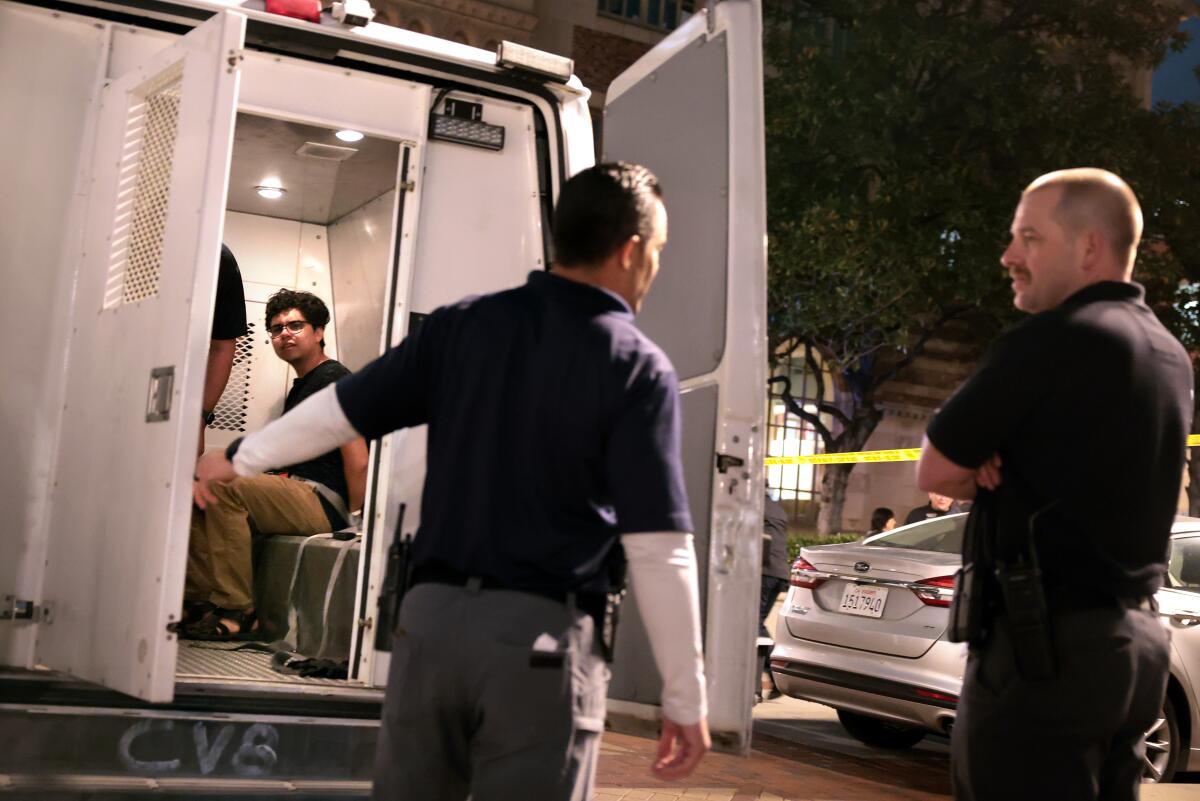
That report, which is significantly shorter than the UCLA one, was less critical. USC did not reply to a request for comment about on the finding, which said that LAPD deployed 619 officers the campus over three days between April 24 and May 5. The report’s recommendations included that police do a better job at “tracking personnel” in order to estimate costs and more closely follow reporting procedures on use of force.
Police used force on two occasions at USC. In one, an LAPD officer fired a 40mm round at a protester, and in the other an officer used a baton. Neither incident resulted in injuries, the report said. But, the cases weren’t immediately investigated, as required by department policy, because of the department’s reliance on paper records.
More to Read
Sign up for Essential California
The most important California stories and recommendations in your inbox every morning.
You may occasionally receive promotional content from the Los Angeles Times.
